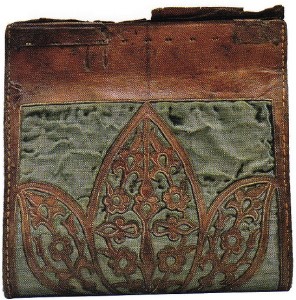| |
Some
considerations on the need for a renewed methodology in
embroidery research.
Rosalia Bonito Fanelli, Textile
Historian
Over the past two months I have noted in a current Florentine
Bargello Museum exhibition and in a London
Textile Society symposium an urgent contemporary
need for consolidating more technical approaches to
embroidery - and textile studies as well.
“Il Medioevo in Viaggio”
- The Voyage in the Middle Ages
The Museo Nazionale del Bargello,
Florence, Italy, celebrates its 150th
anniversary.
curators: Benedetta Chiesi, Ilaria Ciseri (the
Museum’s Director) , Beatrice Paolozzi Strozzi (the
Senior Director)
www.unannoadarte.it/Mostre/il-medioevo-in-viaggio
20 March-21 June 2015, the
catalogue is in Italian
A collaborative project of the “Réseau des
Musées d’Art Médiéval (founded in 2011), the
exhibition opened in Paris at the Musée de
Cluny (October 2014-February 2015).
CIETA members are involved in this network.
These 19th century museums sought mutual
European cultural roots; hence, Neo-Gothic
Revivalism. This spurred donations from idealistic
private collectors.
In Florence, the Bargello acquired its
objects given by the “foreigner colony” - Louis
Carrand, Karl Ressman and Giulio Franchetti, but also
ecclesiastical objects gathered during the 1860’s
suppression.
The Musée de Cluny (Paris 1843), the Bargello
National Museum (Florence 1865), the Schnütgen
Museum (Cologne 1906; objects gathered by Canon
Alexander Schnütgen and the Museu Episcopal (Vic,
Catalonia) have collaborated on this travelling
exhibition.
The curators view the everyday aspect of the Medieval
Voyage – the ordinary or special needs of a pilgrim
driven by the pursuit of Redemption or Money or Glory.
And so the exhibition curators have taken a fresh
approach to The Journey by displaying and
commenting on the over 100 documents and material
objects according to 5 broad themes:
It seems to me that the approach here is an evolution
from the 20th-century French
“cultural material” concept: more
anthropological rather than traditional museum
methodology.
The first contemporary impulse, I think, came from the
Claude Lévi-Strauss Quai Branly Museum installation.
I, personally, began my Italian textile studies and
thesis with Prof. Ulrich Middeldorf by cataloging the
Carrand and part of the Franchetti textile
collections. Fortunately I had had the CIETA
training which was not known then in Italy.
The age of the present generation of museum visitors is a
crucial point to be considered for a museum’s
survival!
The contents of the exhibition is structured in 5
sections:
1. The representation of the then-known world:
geographical maps and navigation instruments (xiith-xvth
centuries)
2. The voyage for salvation : pilgrims, preachers,
clerics
3. War: crusades, knights, military expeditions
4. Commerce and Politics: merchants, bankers,
couriers
5. The journey of status and power : Royal Courts on view
The essays in the catalogue by the various museum
curators treat firstly the 19th-century
Neo-Gothic ambiance and then the principal exhibition
themes.
Here I just briefly comment on two of the
embroidery-related objects because I am interested in
knowing my CIETA colleagues’ views. (rbonito@alice.it )
|
 1)
1) 2)
2)